Divine Greece Tour – Athen, Mykonos, Santorini, Nafplio, Hydra, Epidaurus, Olympia, Delphi, Meteora – 14 Days
April 28 – May 13, 2026
Price – $9000.00 per person
Refundable if you cancel within 3 months of embarking, by the end of the day, January 28, 2026.
Part 1 – Divine Greece Tour – Athens, Mykonos and Santorini
Greece’s most famous islands.
Cobblestone streets, arched, whitewashed facades, cobalt-colored roofs, and rustic windmills are just a few of the picturesque Greek landscapes you can expect to find on this tour. Walk through ancient history and open-air museums in the capital, Athens. Then, revel in the serenity and diversity of the Greek Islands on the isles of Mykonos and Santorini—daydreams come to life in a hundred shades of blue. And Part 2 you’ll enjoy Greece’s original capitol, Nafplio, Hydra Island and the Athenian Riviera where you’ll build a more vibrant picture of Greece—one sparkling with cerulean and emerald to complement those white-washed walls and structures.
Your Part 1 tour package includes
- 7 nights in handpicked hotels
- 7 breakfasts, and 3 dinners served with beer or wine
- 3 immersive sightseeing tours, including a guided walk through the ancient Acropolis
- 1 expert Tour Director, your storyteller through myth and history
- 2 local guides who bring the legends of Greece to life
- Pre-booked transportation, including 1 private deluxe motor coach and 1 on-tour flight
- 2 scenic ferry rides across the sparkling Aegean Sea
- Entrances to museums, landmarks, and more—so you can skip the lines
Included highlights
- Standing in awe atop the Acropolis as the Parthenon glows in the Greek sun
- Tasting fresh feta and olives on a sun-drenched terrace
- Wandering the labyrinthine alleys of Mykonos Town, where bougainvillea spills over whitewashed walls
- Snapping photos of the iconic windmills silhouetted against a Cycladic sunset
- Sinking your toes into the volcanic black sands of Santorini’s beaches
- Exploring the ancient city of Akrotiri, frozen in time by a volcanic eruption
Part 1 – Divine Athens, Mykonos and Santorini
Overnight Flight – 1 night
Day 1: Travel day
Board your overnight flight to Athens.
Athens – 2 nights
Day 2: Arrival in Athens
Included meal: Welcome dinner
Nothing can prepare you for the sheer sense of awe you’ll feel when you come face-to-face with Athens, where ancient architecture and artifacts coexist with modern life. Meet up with your dedicated local guide, who will introduce you to the highlights of this bustling capital.

Meet your Tour Director and fellow travelers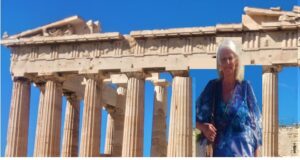 at 1pm and walk to the Acropolis where we’ll see the crowning glory of the Acropolis, the Temple of Athena (on the left), also called Erechtheion. the ancient architectural masterpiece built during the Golden Age of Athens, over 2500 years ago. And there’s that Parthenon (on the right) that stands as one of the most revered and recognized sites in the world. You may have seen these enduring icons of antiquity in books and film, but now you’re stepping through the work of craftsmen who quarried and honed these marble blocks thousands of years ago.
at 1pm and walk to the Acropolis where we’ll see the crowning glory of the Acropolis, the Temple of Athena (on the left), also called Erechtheion. the ancient architectural masterpiece built during the Golden Age of Athens, over 2500 years ago. And there’s that Parthenon (on the right) that stands as one of the most revered and recognized sites in the world. You may have seen these enduring icons of antiquity in books and film, but now you’re stepping through the work of craftsmen who quarried and honed these marble blocks thousands of years ago.
We’ll have some free time until we meet for welcome celebration dinner.
Day 3: Free time for sightseeing: check out nearby Plaka or the rest of Athens or catching up on resting – until our dinner together.
Included meal: Breakfast and Dinner
Take morning stroll through the lively Plaka area, the oldest section of Athens, a neighborhood of charming restaurants, shops and sidewalk cafes.
- Walk through the Plaka and enjoy free time to wander the narrow streets and charming shops. Situated at the foot of the Acropolis, this district is one of the oldest parts of Athens and is known as “the neighborhood of the gods” due to the dozens of monuments strewn throughout.
Plaka, Metropolis Square Holy Metropolitan Church of the Annunciation of the Virgin Mary
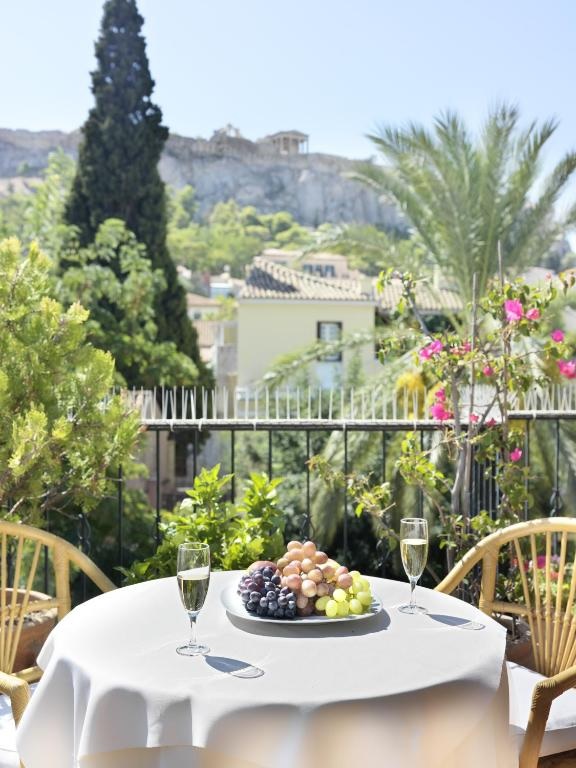
Plaka is below the Acropolis.
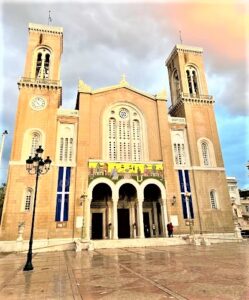
The Divine Mother created the human soul to protect them and to give them the potential of igniting the divine spark within. Only those with devotion to the divine who work hard and obtain a divine spiritual disciplined such as an initiate who obtains their divine adepthood (being) will be given the Divine Mother’s permission to enter the divine realm where she oversees their journey.
Her world as an immortal is on the human world, as well. As she has performed many miracles that have been acknowledged by the human souls who have witness them. She saved the planet. She wasn’t asking for anything in return. The human souls on her human planet where she was born, Earth, are asking that she be given an appropriate home according to her rank and titles which is the highest on this human planet, Earth, where she was born and where she currently calls her home.
The Divine soul represents the Divine Feminine which is capable of transcending the earth, unlike the Divine Masculine who requires the Earth, to be in his power, she doesn’t require the Earth to be in her power. A human being cannot do that. She’s more than a human being. She’s a divine soul. Some divine soul can enter and leave any church and anywhere, they want to. But some aren’t allowed to come and go, as they please, by the Most-High Divinity, the Divine Mother, who’s also, the Most-High Sovereignty, the Prime Creatrix.
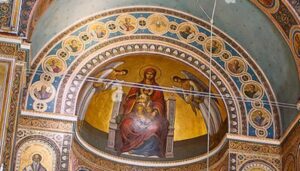 Some can enter the Holy Metropolitan Church of the Annunciation of the Virgin Mary in Metropolis Square and leave. But most can’t unless they are devoted to the divine.
Some can enter the Holy Metropolitan Church of the Annunciation of the Virgin Mary in Metropolis Square and leave. But most can’t unless they are devoted to the divine.
There’s an impressive fresco of the Divine Mother located in the Prothesis over the altar, refer left.
Some will lite a candle for a loved and say a pray and make a connection with the divine, but most won’t, unless they are devoted to the divine.
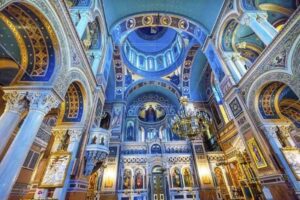
In August, especially on August 15, all over Greece there are festivals to commemorate Divine Christianity, the Divine Mother, or Panagia. The 15th is a public holiday in Greece and around the world.
Many Christians believe the Divine Mother resurrected after her transfiguration on the 3rd day and that she’s divine and immortal.
And in 1950, the pope tried to prevent the Divine Mother from being immortal and existing on the planet and his attempt failed.
Free time until we meet for dinner.
Take an aftternoon stroll through the lively Plaka area, the oldest section of Athens, a neighborhood of charming restaurants, shops and sidewalk cafes.
You might catch a glimpse of the colorfully-costumed Evzone guards, outfitted in the traditional Greek style, on Constitution Square.
In the evening, we’ll visit one of the most popular fish-tavernas in the area and have a Greek fish-seafood dinner.
We’ll return safely to our hotel for a good nights sleep.
Enjoy a free afternoon in Plaka, a neighborhood largely unbothered by time and modernity, with distinctive red-tiled rooftops, outdoor cafes, and colorful street vendors.
Mykonos – 2 nights
Day 4: Ferry to Mykonos & sightseeing tour
Included meals: Breakfast, Dinner
 We’re off to the islands! Travel by ferry to Mykonos and join your Tour Director on a walk through Mykonos Town’s narrow, labyrinthian streets bursting with cafes, galleries, and shops. We’ll see the “Tria Pigadia” (“Three Wells”, in English). The legend says that unmarried girls will find husbands after drinking a sip of water from each well! I say, “find yourself first, have some divine experiences on this journey and love will follow”.
We’re off to the islands! Travel by ferry to Mykonos and join your Tour Director on a walk through Mykonos Town’s narrow, labyrinthian streets bursting with cafes, galleries, and shops. We’ll see the “Tria Pigadia” (“Three Wells”, in English). The legend says that unmarried girls will find husbands after drinking a sip of water from each well! I say, “find yourself first, have some divine experiences on this journey and love will follow”.
Surrender to the soft, salty air on The Island of The Winds with its famous windmills, dating back to the 16th century, when islanders used wind power to grind grain. There are 16 windmills in total, and while they are no longer operational, they stand as a monument to early innovation.
- The views here are spectacular: From this hilltop perch, you can see Chora, the capital of Mykonos and the harbor in the distance. Marvel at the sapphire blue water of the Aegean Sea that matches the blue domes of some of the churches which we’ll be taking a look at. There’s a nearby Mykonos Archeological Museum.
- Pass the Church of Panagia Paraportiani, eminently photographed for its Byzantine-era, whitewashed facade and intriguing curves.Located in the town of Chora, its name literally means “Our Lady of the Side Gate” in Greek, as its entrance was found in the side gate of the entrance to the Kastro area.Construction of this church started in 1425 and was not completed until the 17th century. This impressive, whitewashed church actually consists of five separate churches which are joined: the four churches (dedicated to Saint Eustathios, Saint Sozon, Saints Anargyroi and Saint Anastasia) are at ground level and constitute the base of the fifth church that has been built above them.
- Delight in Little Venice along the Old Harbor —perched right alongside the Aegean Sea shoreline and inspired by its Italian namesake—where the colorful sun-splashed residences seem to melt into the water, their balconies hanging over the sea.
Sit down this evening for an included dinner.
Day 5: Free day in Mykonos
Included meal: Breakfast
Use your free day in Mykonos to hit the cobblestones early and take your time. If visiting the island’s famous beach clubs isn’t your speed, head back to Little Venice for a stroll along the Old Harbor; hike down (or grab a taxi) to Armenistis Lighthouse, one of the oldest in Greece; or get lost in Matogianni Street’s shops and galleries.

 In Mykonos Town visit the Church of the Virgin of St. Rosary a Catholic Church which is situated in Alefcandra Square near the picturesque windmills of Mykonos.
In Mykonos Town visit the Church of the Virgin of St. Rosary a Catholic Church which is situated in Alefcandra Square near the picturesque windmills of Mykonos.
The icon above the Holy Table depicts the Madonna and Child between St. Dominic, the apostle of piety of St.Rosary, and St. Catherine of Sienna. It was transported to Mykonos from Venice in 1715.
There will be many chances to feel the divine presence. And this church is no exception. The divine is everywhere, especially when you light candles and ask for its guidance.
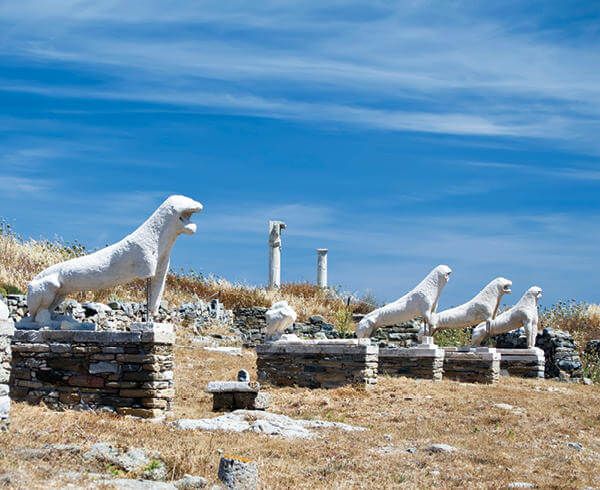
Santorini – 2 nights
Day 6: Ferry to Santorini
Included meal: Breakfast
You’ve seen the photos—now get ready to star in them yourself. Take a ferry to Santorini and enjoy a free afternoon on the island. You can admire the steep cliffs that plunge into the Aegean and the island’s iconic caldera, dotted with whitewashed buildings. You can eat your way through traditional dishes—like moussaka, a hearty eggplant dish, or tomato fritters—then use your free time to explore unique pebbly beaches and crystal clear waters.
Visit to local winery for a tour and a tasting in the village of Oia.
Looking to expand your palate? The visit will either take place on the evening of day 6 or the morning of day 8, depending on ferry and flight schedules.
Here, you’ll join a trained sommelier to learn about Greece’s proud grape-growing tradition and the types of grapes that thrive in Santorini’s volcanic soil, including Assyrtiko. Then, enjoy tastings of different local wines paired with a variety of small bites.
Day 7: Sightseeing tour of Santorini
Included meal: Breakfast
Your guided tour of Santorini will take you from dramatic black-sand beaches to jagged cliff-lined shores and back—a stark contrast to the island’s beloved whitewashed buildings and sprays of bright fuchsia bougainvillea vines.
- Visit the archaeological excavations at Akrotiri, a settlement buried in volcanic ash, where richly pigmented Bronze Age frescoes and other Minoan artifacts survived a devastating volcano eruption in the 16th Century BCE.
- See Mount Profitis Ilias, the highest point on all of Santorini and home to the Prophet Elias Monastery which sits perched atop the summit.
- Stop in small, picturesque Pyrgos, where you’ll weave through the steep streets of this slightly off-the-beaten-path village.
Part 2 – Divine Meteora and Delphi –
Kalambaka & Meteora – Monasteries Tour
Day 8
After breakfast a flight to Kalambaka and a scenic drive brings us to Thermopylae, famous for the heroic defence by Leonidas and his brave Spartans against the invading Persians.
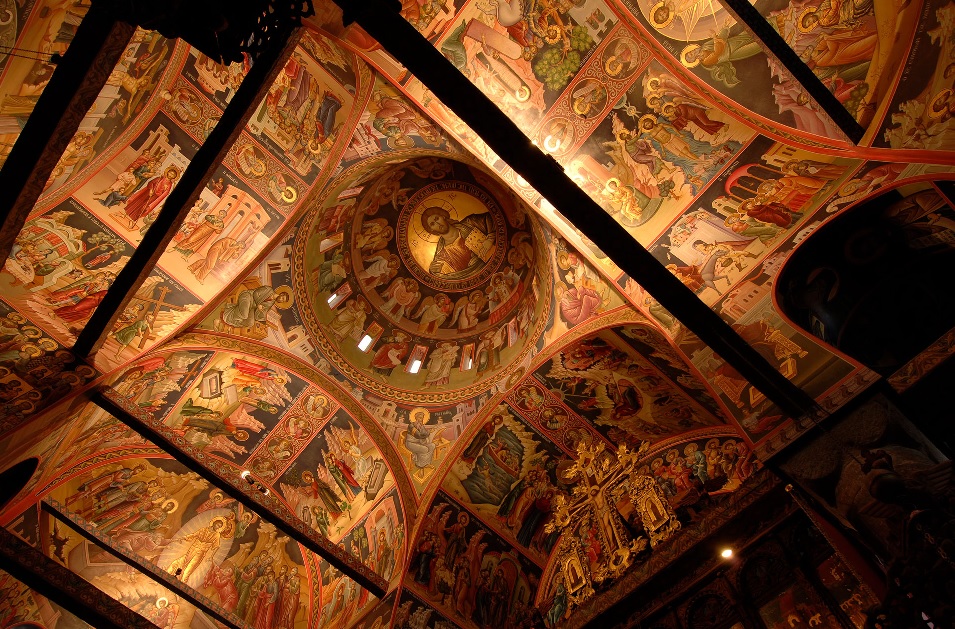
We cross the lush Thessaly region, the ‘breadbasket of Greece’, then travel over the Pourmaraki Pass to Kalambaka. And we’ll check into our 4-star family-friendly hotel near Kalambaka Tourist Information Center where your room will have a view of Meteora.
Then we’re off to see Meteora meaning “suspended in the air”, and tour 2 out of 6 mystical Christian Orthodox monasteries incredibly nestled securely on the edge of extraordinary rock formations.
Along with Roman Catholicism and Protestantism, Greek Orthodox Christianity is one of the world’s three major Christian traditions. But unlike the other two large branches of Christianity, which have spread throughout the developing world, Eastern Orthodoxy remains largely confined to Europe. There’s also Oriental and Russian Orthodoxy in Asia. The total number of Orthodox is estimated at about 300 million members. The basis of the original Orthodox community is the Creed of Constantinople, written in 381.
The Meteora monasteries are holy places, and some have a dress code as follows: Women wear skirts below the knees or bring a large scarf that will cover your knees. Men wear long pants and jacket to cover arms.
Most of the Meteora monasteries were built in the 1500’s and then added to over the centuries.
We’ll see the Monastery of St Stephen, one of the more easily accessible of the monasteries, built in the late 12th century.

This monastery has been restored numerous times and added to until it’s current form as a nunnery since 1961 and where the sisterhood of nuns are known for their remarkable social action.
Meteora is a monastic site that is increasingly gaining significance as a World Heritage site, as a tourist destination and as functioning “living sites of the present” influenced by wider changing circumstances which is a new approach from “monuments of the past” approach. Living sites: the past in the present approach.
The “living sites” approach concentrates on communities as the creators of the sites, viewing communities and sites as an inseparable entity. The ultimate aim is to shift the focus of conservation from ‘protection’ towards a continual process of ‘creation’ in an ongoing present, attempting to change the way heritage is perceived, protected and, more importantly, further created with spiritual and construction works stemming from the divine and their representatives, i.e., the divine ‘Ministry of Spirituality and Culture’.

Next, we’ll see the Great Meteoron Monastery that is the largest, oldest and best known monastery in Meteora where there’s housing for Christian monks. Most of the Meteora monasteries were built in the 1500’s and then added to over the centuries.
Also called Megalo Meteoro or Metamorphisis, the first church of the Transfiguration of the Savior was built in the 14th century upon the highest rock.
At the sanctum of the catholic there are important frescos of the Macedonian school and the remarkable frescos of the main church and the narthex are believed to be created by Georgie, student of Theophanous the Cretan.
There is the chapel of the divine Mother of God (Virgin Mary of the Meteorite Stone). Some other important buildings at the centre are the kitchen, and dining hall, called the “trapeza”.
Then, we’ll return to our beautiful hotel for freetime and for dinner in the evening.
Overnight:Davani Meteora Hotel, Kalambaka
Meals: Breakfast, Dinner
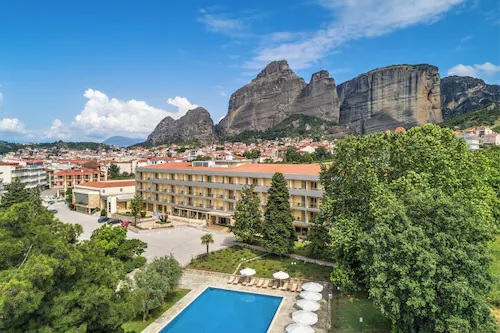
Day 9
Kalambaka
We’ll eat breakfast and have a free day to relax, rejuvenate, enjoy the beautiful scenery, Kalambaka and our magnificent hotel with spa.
Delphi, Temple of Apollo

Day 10
After breakfast we’ll leave Kalambaka and travel to Delphi where we’ll tour the imposing 4th century B.C. the spiritual and religious centre of the ancient world.
Delphi that was a powerful home of the oracle and it was called Omphalos of the world.
Declared a UNESCO World Heritage Site, it’s situated in a uniquely beautiful location, perched on the slopes of Mount Parnassos.

Tread in the footsteps of the ancient Greeks, who would descend on the sanctuary of Delphi to consult with the most important oracle in the classical world and walk the Sacred Way to the 4th-century Temple of Apollo.
You’ll have time to go the museum on your own and view the statues immortalizing the strength of the athletes who once competed in the Pythian Games, held in honor of Apollo and the Arts.
We’ll return to our hotel for leisure time.
We’ll dine together, in the evening.
Get a good-night’s sleep.
Part 3 -Divine Nafplio, Hydra Island and the Athens Riviera via Epidaurus
Athens Riviera – 1 night
Day 11: Mycenae – Athens Riviera via Epidaurus
Included meal: Breakfast
We’ll cross the mighty Corinth Canal to the wild Peloponnesian Peninsula. Arriving in Corinth, we’ll explore an ancient city that several empires fought over throughout the centuries. We’ll continue to Mycenae, a mighty kingdom of Ancient Greece, where we’ll see the Beehive Tombs (the Treasury of Atreus), the Lion Gate and the remains of Agamemnon’s Royal Palace.
Mycenae, heart of a prehistoric Bronze Age Greece, powerhouse. Immerse yourself in the city’s unique mix of Greek, French, Venetian, and Ottoman cultures—and maybe take a dip in the waters of the Aegean, too. Fall in love with its seaside splendor, then wrap up your trip with one relaxing night on the Athenian Riviera. Still craving history? Don’t worry.
We make a stop in old Epidaurus, home to a brilliantly preserved theater and one of the most important healing centers of antiquity.
- Explore Mycenae’s citadel, including its main entrance, the Lion Gate. Erected sometime near 1250 B.C. and distinguished by twin lionesses over its threshold, it’s the largest surviving prehistoric sculpture in the Aegean.
- Visit another archaeological site of epic provenance: the Treasury of Atreus. Also known as the Tomb of Agamemnon, this beehive-shaped burial ground (or “tholos” in Greek) dates back over three millennia and is inextricably linked to the mythical Trojan War through the kings for which it’s named.
- Visit the royal cemetery known as Grave Circle A, which supposedly holds the remains of Agamemnon and his followers—and where treasures like the golden Mask of Agamemnon were unearthed.
Head into the countryside for a guided tour of the Sanctuary of Asklepios, a UNESCO World Heritage Site in the ancient Greek city of Epidaurus.
- Learn about its history as a healing sanctuary dedicated to the Greek god of medicine, where people went in search of physical and spiritual healing.
- Move on to the Ancient Theater of Epidaurus, one of the best-preserved Greek amphitheaters in the world and yet another UNESCO-recognized landmark.
Enjoy dinner and begin Part 3 of your Divine Greece Tour.
Nafplio –
Day 12: Nafplio via Mycenae
Included meal: Breakfast
Continue on to Nafplio and join your Tour Director on a walk through its charming old town.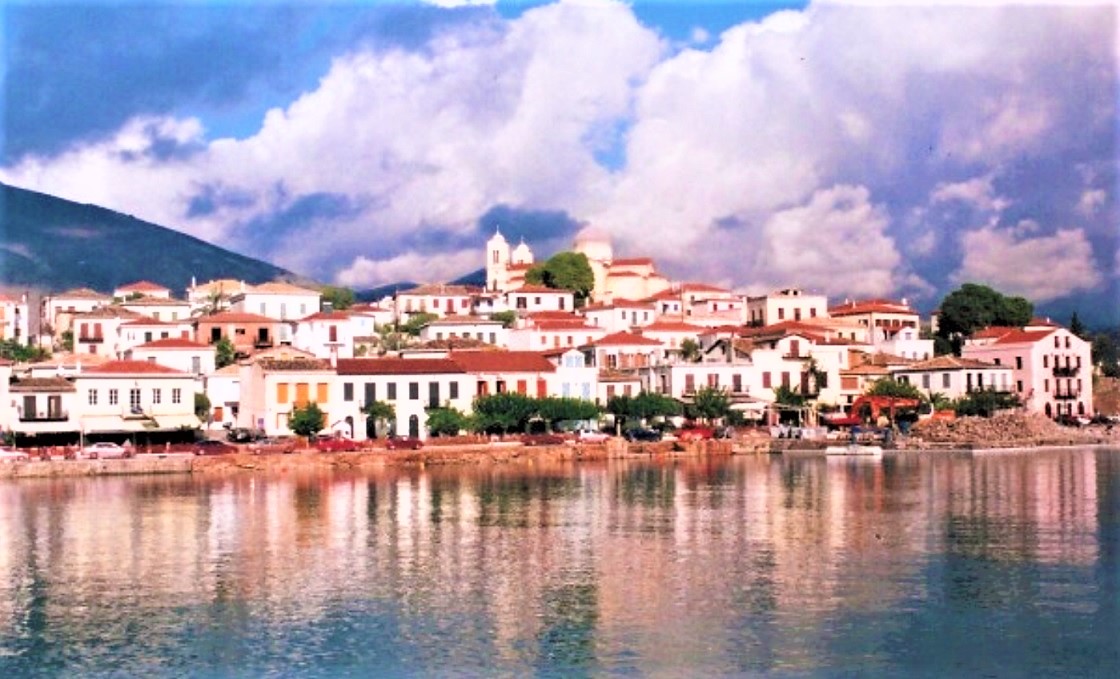
- Roam through its bustling, taverna-lined squares and spot the imposing Palamidi, a Venetian fortress perched atop a hill over 700 feet above the city.
- Learn about Nafplio’s history, including how it became the first capital of independent Greece in 1829.We’ll arrive in the Nafplion a picturesque seaport of Nafplio in the historic Argolis area of Greece. The rest of the day is at your leisure. Enjoy the comfortable hotel and explore the nearby beaches Arvanitia Beach is a 7 minute walk. The National Gallery and Archeological Museum are nearby. Nafplio is the first capital of Greece. Nafplio remained the capital of the kingdom until 1834, when King Otto decided to move the capital to Athens. It’s one of the most romantic towns with stone pathways and many coffee shops and restaurants with traditional tastes.
Day 13: Hydra Island
Included meal: Breakfast
The Saronic island of Hydra is a haven for artists and others seeking peaceful retreat. Please note: Travelers must be comfortable walking for at least 2 hours with little sitting as there are no motor vehicles on the island.
Begin by making your way to the seaside village of Metochi, where you’ll then board a ferry to the island. Once on Hydra, you’ll meet up with a local guide for a walking tour of this serene island’s main town. Step inside the Rafalia pharmacy to see homemade herbal remedies in one of Greece’s oldest pharmacies.
Stroll past the house that singer-songwriter Leonard Cohen once called home before entering the beautifully preserved, Neoclassically styled Pavlos Kountouriotis Mansion. After visiting this mountaintop retreat, sit down for an included lunch on the island.
Please note: Travelers must be comfortable walking for at least 2 hours with little sitting as there are no motor vehicles on the island.
Included meals: Breakfast, Farewell dinner
Celebrate your trip with your group at tonight’s farewell dinner, served with beer or wine.
Kali antamosi—or “until we meet again.”
Day 14
Athens
We’ll take a 7:30 am ferry from Hydra to Piraeus, 2 hrs. Then Athens Airport Transfer
Included meal: Breakfast (early)
Tip:
Bring European electric plug adapter for your USA appliances.
*CTS Tours reserves the right to make changes to this tour’s itinerary, Divine Greek Tour, that will be of benefit and will insure a successful completion of the tour. CTS Tours while follow it as best it can, with possible changes in the future, in hotels and the sequencing of events or additions or subtrations of events so it will run smoothly.
CTS Tours doesn’t guarantee the accuracy of a hotel’s description in their advertisement, however, currently, CTS is satisfied that it’s done it’s best to verify the information when possible. If a hotel is changed, in the future, it will be replaced with a hotel with an equivalent number of stars or better.

